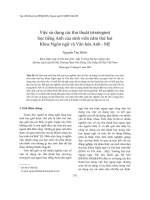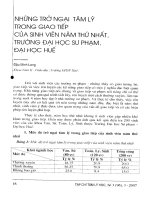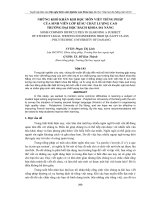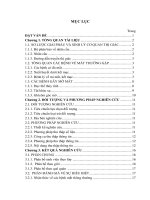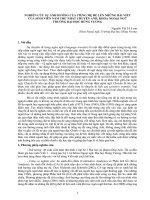Những chiến lược sửa các lỗi thường gặp khi phát âm nhóm phụ âm cuối trong tiếng Anh của sinh viên năm thứ hai chuyên tiếng Anh trường Đại học Phương Đông
Bạn đang xem bản rút gọn của tài liệu. Xem và tải ngay bản đầy đủ của tài liệu tại đây (1.51 MB, 76 trang )
VIETNAM NATIONAL UNIVERSITY, HANOI
UNIVERSITY OF LANGUAGES AND INTERNATIONAL STUDIES
FACULTY OF POST-GRADUATE STUDIES
oo0oo
NGUYỄN THỊ HẢI
STRATEGIES TO CORRECT COMMON ERRORS IN
PRONOUNCING ENGLISH FINAL CONSONANT CLUSTERS
MADE BY SECOND-YEAR ENGLISH-MAJORED STUDENTS
AT PHUONG DONG UNIVERSITY
(NHỮNG CHIẾN LƯỢC SỬA CÁC LỖI THƯỜNG GẶP KHI PHÁT
ÂM NHÓM PHỤ ÂM CUỐI TRONG TIẾNG ANH CỦA SINH VIÊN
NĂM THỨ HAI CHUYÊN TIẾNG ANH TRƯỜNG ĐẠI HỌC
PHƯƠNG ĐÔNG)
M.A. Minor Programme Thesis
Field: English Language Teaching Methodology
Code: 60 14 10
Hanoi – 2011
VIETNAM NATIONAL UNIVERSITY, HANOI
UNIVERSITY OF LANGUAGES AND INTERNATIONAL STUDIES
FACULTY OF POST-GRADUATE STUDIES
oo0oo
NGUYỄN THỊ HẢI
STRATEGIES TO CORRECT COMMON ERRORS IN
PRONOUNCING ENGLISH FINAL CONSONANT CLUSTERS
MADE BY SECOND-YEAR ENGLISH-MAJORED STUDENTS
AT PHUONG DONG UNIVERSITY
(NHỮNG CHIẾN LƯỢC SỬA CÁC LỖI THƯỜNG GẶP KHI PHÁT
ÂM NHÓM PHỤ ÂM CUỐI TRONG TIẾNG ANH CỦA SINH VIÊN
NĂM THỨ HAI CHUYÊN TIẾNG ANH TRƯỜNG ĐẠI HỌC
PHƯƠNG ĐÔNG)
M.A. Minor Programme Thesis
Field: English Language Teaching Methodology
Code: 60 14 10
Supervisor: Nguyễn Hoàng Lan, M. A
Hanoi - 2011
iv
TABLE OF CONTENTS
CANDIDATE’S STATEMENT i
ACKNOWLEDGEMENT ii
ABSTRACT iii
TABLE OF CONTENTS iv
LIST OF TABLES, CHARTS vii
PART 1: INTRODUCTION 1
1. Rationale of the study 1
2. Aims of the study 2
3. Scope of the study 2
4. Method of the study 3
5. Thesis Design 3
PART 2: DEVELOPMENT 5
CHAPTER 1: LITERATURE REVIEW 5
1.1. English pronunciation 5
1.1.1. Standard English Pronunciation 5
1.1.2. Aspects of English pronunciation 5
1.1.2.1. Consonant sounds 6
1.1.2.2. English final consonants and consonant clusters 7
1.1.2.3. A comparison between English and Vietnamese final consonants.9
1.2. Errors 12
1.2.1. Errors vs. Mistakes 12
1.2.2. Pronunciation errors 13
1.2.3. Final consonant clusters errors 13
v
1.3. Error correction 14
1.3.1. Definition and types of error correction 14
1.3.2. Approaches to error correction 16
1.4. Techniques to deal with final clusters 16
CHAPTER 2: AN OVERVIEW OF TEACHING AND LEARNING
PRONUNCIATION AT PDU 21
2.1. The syllabus 21
2.2. The learners 22
2.3. The teachers 22
2.4. The teaching and learning conditions 22
CHAPTER 3: METHODOLOGY 24
3.1. Research questions 24
3.2. Subjects of the study 24
3.3. Data collection procedure 24
3.4. Data analysis procedure 25
CHAPTER 4: FINDINGS AND DISCUSSIONS 26
4.1. Findings from recordings and discussions 26
4.1.1. Overview of the errors with final clusters of 2
nd
year English-majored
students at PDU 26
4.1.2. Details of the errors with final clusters of 2
nd
year English-majored
students at PDU 27
4.1.2.1. Reduction 27
4.1.2.2. Substitution 30
vi
4.2. Findings from observation and discussions 31
4.3. Comparison of the two findings 33
4.4. Strategies to correct final clusters errors 33
PART 3: CONCLUSION 38
1. Summary of major findings 38
2. Limitations and suggestions for further study 38
REFERENCES 40
APPENDIX 1: Checklist for recording I
APPENDIX 2: Findings from recordings II
APPENDIX 3: Checklist for observation XIX
APPENDIX 4: Findings from observation XXVI
vii
LIST OF TABLES
Table 1: Table of consonant sounds pp. 6-7
Table 2: Component of consonant clusters pp. 8-9
Table 3: Reduction errors found in the data from recordings pp. 27-28
Table 4: Substitution errors found in the data from recordings p. 30
Table 5: Errors from students’ reading out loud the 230 errors from recordings p. 31
Table 6: Details of errors from observation p. 32
LIST OF CHARTS
Chart 1: Types of errors p. 26
Chart 2: Comparison of two results from recordings and observation p. 33
1
PART 1: INTRODUCTION
1. Rationale of the study
English has become an important demand for schooling and job opportunities in the past
few years; however, many Vietnamese speakers do not have intelligible English
pronunciation so as to be easily understood in direct communication with foreigners.
Learners with serious pronunciation errors will certainly fail in communication. Therefore,
it is very essential to research learners‟ pronunciation errors, and then to seek out suitable
strategies to solve the problems.
Among many pronunciation errors that learners of English as a second language are likely
to make (i.e. intonation, stress, ending sounds, etc.), errors with final consonant clusters
can be considered serious because “learners‟ inability to produce final consonant clusters
can lead to incomprehensibility” (Avery & Erhlich, 1992, p.55). In the same line, Celce-
Murcia, Brinton & Goodwin (1996) supported that inaccurate pronunciation of consonant
clusters can make English language learners‟ speech difficult for native speakers to
understand, particularly in cases where the learners use epenthesis to break up clusters or
omit a consonant in a cluster (as cited in Arnold, 2009).
Serious as it might be, problems with final clusters can be considered as one typical
pronunciation error of Vietnamese learners. According to an earlier research by the
Australian Government publication Asian Language Motes (1978; as cited in Pham, 2009),
“initial clusters do not cause many problems, but final clusters are found extremely hard
for Vietnamese students”. Also in an article about common challenges faced by
Vietnamese learners, Deshayes (2005, p.6) firmly stated that “English consonant clusters
give Vietnamese learners problems not only because they do not have these consonant
combinations in their own language, but also because they produce a variety of syllable
types”.
2
Although final clusters errors are very common to Vietnamese learners, it seems that
teachers do not pay much attention to them. Firstly, it is perhaps because the final sounds
are not pronounced as clearly as other sounds in an utterance so they are less noticed by
both learners and teachers. In addition, few researches have been carried out on these
particular final clusters errors. The latest and most noticeable research on this issue was
done by Pham (2009); however, it did not analyze deeply students‟ final clusters errors as
well as did not suggest particular strategies for correcting them.
Being an English teacher at Phuong Dong University (PDU), I realize that many of my
students encounter difficulty in pronouncing English final clusters though they are able to
produce single consonants accurately. For the above reasons, I would like to conduct this
research entitled “Strategies to correct errors in pronouncing English final clusters
made by second- year English-majored students at PDU”.
The research hopes to find answers to the following questions:
What are the English final cluster errors that second-year English-majored students at
PDU often make?
What are some strategies to correct those errors?
2. Aims of the study
The main aim of the study is to analyze final clusters errors in pronunciation of the second-
year students in English Department, PDU, and then to suggest strategies to help teachers
deal with students‟ final clusters problems.
3. Scope of the study
There are many pronunciation errors that Vietnamese students are likely to make.
However, within the limit of a minor thesis, this study focuses on analyzing the students‟
final clusters errors and proposing the strategies for correcting them.
3
This study was implemented for a group of 30 English-major second-year students at
Phuong Dong University who are working with the course book “Let‟s talk 2” by Leo
Jones (2002).
4. Method of the study
30 English-majored second-year students from class 509701A2 were chosen to participate
in this study. Recording and observation were two methods used to collect data. The data
analysis procedure included two steps. In the first stage, all the speeches that the students
presented in their mid-term oral test were recorded and used for take-home analysis. Next,
all the errors made by students were counted in terms of types, sounds frequency and
seriousness in order to find out a list of common pronunciation errors students make with
final clusters. At the same time, tapes recorded from students were sent to a group of three
English teachers to help analyze and find errors and error frequency. After that, the data
were converted into tables and charts. In the second stage, the results from recording
analysis were used to design a checklist for observation process when each student was
asked to read the words individually. The results collected from observation were then
compared with the results from recording analysis to prepare for the next stage where
suitable solutions to students‟ pronunciation errors with final clusters were suggested.
5. Thesis Design
This thesis consists of three parts, namely Introduction, Development and Conclusion.
Part 1, the Introduction, presents the rationale, the aims, the scope and the method of the
study.
Part 2 is the development with four chapters. Chapter 1 (Literature review) introduces
some key concepts necessary for understanding this research including Standard English
Pronunciation, English final consonants & consonant clusters, Vietnamese final
consonants, Errors vs. mistakes, Pronunciation errors and Error correction. Also, it reviews
some previous studies related to the topic. Chapter 2 (Setting) gives an overview of
4
English pronunciation teaching and learning context at PDU. Chapter 3 (Methodology)
demonstrates a clear and detailed plan to collect adequate and reliable data for analysis
including the selection of subjects, research instruments, procedures of data collection as
well as procedures of data analysis. Chapter 4 (Results and Discussions) mainly deals with
the findings from the recordings and observation. Some discussions about these findings
can also be found in this chapter.
Part 3, the Conclusion, discusses the major findings and limitations of the research as well
as provides suggestions for further study.
5
PART 2: DEVELOPMENT
CHAPTER 1: LITERATURE REVIEW
In this chapter, the author provides readers with the relevant literature of the study by
introducing some key concepts necessary for understanding this research, as well as the
review of previous studies related to the topic. Some crucial concepts chosen to be clarified in
this part include Standard English Pronunciation, English final consonants & consonant
clusters, Vietnamese final consonants, Errors vs. mistakes, Pronunciation errors and Error
correction.
1.1. English pronunciation
1.1.1. Standard English Pronunciation
First of all, it is essential to define Standard English Pronunciation. Standard English is
defined as “a particular dialect of English, being the only non-localized dialect of global
currency without significant variation, universally accepted as the appropriate educational
target in teaching English; which may be spoken with an unrestricted choice of accent”
(Strevens, 1983, p.88, as cited in McKay, 2002, p.51). Therefore, Standard English
pronunciation can be any dialect of English that is widely used and accepted in the world.
It is common knowledge that there are two major dialects of English for international
broadcasts and in social and business settings: Received Pronunciation (RP) in the United
Kingdom and General American (GA) English in the United States. Vietnamese people tend to
follow RP English in which the /r/ sound is not pronounced at the end of words, so RP English
will be used as the criteria for analyzing students‟ pronunciation in this research.
1.1.2. Aspects of English pronunciation
Pronunciation is a complicated concept that involves many aspects. Generally, it can be
broken into the following components: vowels, consonants, word stress, rhythm, intonation,
and other aspects of connected speech (assimilation, elision, linking and intrusion). Basically,


